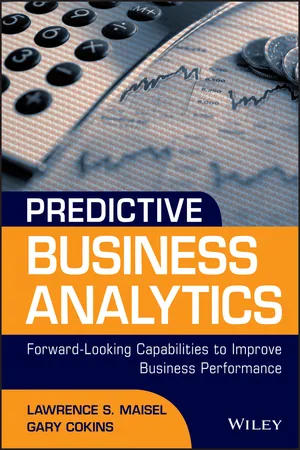
Predictive Business Analytics
Forward Looking Capabilities to Improve Business Performance
- English
- ePUB (mobile friendly)
- Available on iOS & Android
Predictive Business Analytics
Forward Looking Capabilities to Improve Business Performance
About This Book
Discover the breakthrough tool your company can use to make winning decisions
This forward-thinking book addresses the emergence of predictive business analytics, how it can help redefine the way your organization operates, and many of the misconceptions that impede the adoption of this new management capability. Filled with case examples, Predictive Business Analytics defines ways in which specific industries have applied these techniques and tools and how predictive business analytics can complement other financial applications such as budgeting, forecasting, and performance reporting.
- Examines how predictive business analytics can help your organization understand its various drivers of performance, their relationship to future outcomes, and improve managerial decision-making
- Looks at how to develop new insights and understand business performance based on extensive use of data, statistical and quantitative analysis, and explanatory and predictive modeling
- Written for senior financial professionals, as well as general and divisional senior management
Visionary and effective, Predictive Business Analytics reveals how you can use your business's skills, technologies, tools, and processes for continuous analysis of past business performance to gain forward-looking insight and drive business decisions and actions.
Frequently asked questions
PART ONE
“Why”
CHAPTER 1
Why Analytics Will Be the Next Competitive Edge
The farther backward you can look, the farther forward you are likely to see.
ANALYTICS: JUST A SKILL, OR A PROFESSION?
In field after field, computing and the Web are creating new realms of data to explore—sensor signals, surveillance tapes, social network chatter, public records and more. And the digital data surge only promises to accelerate, rising fivefold by 2012, according to a projection by IDC, an IT research firm. . . . Yet data is merely the raw material of knowledge. We're rapidly entering a world where everything can be monitored and measured, but the big problem is going to be the ability of humans to use, analyze and make sense of the data. . . . [Analysts] use powerful computers and sophisticated mathematical models to hunt for meaningful patterns and insights in vast troves of data. The applications are as diverse as improving Internet search and online advertising, culling gene sequencing information for cancer research and analyzing sensor and location data to optimize the handling of food shipments.
BUSINESS INTELLIGENCE VERSUS ANALYTICS VERSUS DECISIONS
HOW DO EXECUTIVES AND MANAGERS MATURE IN APPLYING ACCEPTED METHODS?
FILL IN THE BLANKS: WHICH X IS MOST LIKELY TO Y?
- 1. Increased employee retention. Which of our employees will be the most likely next employee to resign and take a job with another company? By examining the traits and characteristics of employees who have voluntarily left (e.g., age, time period between salary raises, percent wage raise, years with the organization), predictive business analytics can layer these patterns on the existing workforce. The result is a rank-order listing of employees most likely to leave and the reasons why. This allows managements' selective intervention.
- 2. Increased customer profitability. Which customer will generate the most profit from our least effort? By understanding various types of customers with segmentation analysis based on data about them (perhaps using activity-based costing as a foundational analysis), business analytics can answer how much can optimally be spent retaining, growing, winning back, and acquiring the attractive microsegment types of customers that are desired.
- 3. Increased product shelf opportunity. Which product in a retail store chain can generate the most profit without carrying excess inventory but also not having periods of stock-outs? By integrating sales forecasts with actual near-real-time point-of-sale checkout register data, predictive business analytics can optimize distribution cost economics with dynamic pricing to optimize product availability with accelerated sales throughp...
Table of contents
- Cover
- Contents
- Additional praise for
- Series Page
- Title Page
- Copyright
- Dedication
- Preface
- PART ONE: “Why”
- PART TWO: Principles and Practices
- PART THREE: Case Studies
- PART FOUR: Integrating Business Methods and Techniques
- PART FIVE: Trends and Organizational Challenges
- About the Authors
- Index
- End User License Agreement